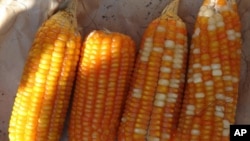Maize breeder Kevin Pixley laughs when asked how to identify his new, nutritious variety.
"Oh, it's beautiful," he says. "The enriched maize is generally bright orange."
Dried ears of brilliant vitamin A-enriched orange maize decorate the tables at a recent conference in Washington, DC. Pixley was one of the experts gathered here to talk about a new method to fight malnutrition among the world's poor.
While nearly one billion people worldwide suffer from chronic hunger, experts say as many as two billion experience what is known as "hidden hunger" - malnutrition brought on by diets that lack critical nutrients such as iron, zinc and vitamin A.
Consequences
The consequences include reduced productivity, stunted children's development, and increased risk of disease and death. Vitamin A deficiency, for instance, is the world's leading preventable cause of blindness, and it greatly increases the risk of serious illness and death. Research shows that delivering supplements to vitamin A-deficient children cuts the death rate by a quarter.
While fruits, vegetables and animal products are excellent sources of vitamins and minerals, many of the world's rural poor cannot afford to eat a balanced diet. Instead, they survive on staple crops that lack many of the nutrients that are essential for good health.
Programs to deliver nutrient supplements or fortify food ingredients have largely failed to reach the rural poor.
New approach
Now, Kevin Pixley and other experts are taking a different approach.
"In many countries of Asia, people eat rice every day," Pixley says. "In many countries of sub-Saharan Africa, people eat maize or cassava every day. So if these foods can be more nutritious, then even the rural poor consumers are going to receive [essential nutrients] on a daily basis."
To make maize more nutritious, Pixley and other researchers found varieties that naturally produce higher-than-normal amounts of vitamin A. But it took years of selective breeding to increase the content to levels that would prevent malnutrition.
They used conventional breeding, not genetic modification, he says, because "in many countries, the use of genetically modified products would be a hindrance to acceptance."
But will it feed my family?
The most important factor for acceptance, however, is not vitamin content. The primary concern, Pixley says, is that the crop produces enough food for farmers to feed themselves and sell a surplus for a profit.
"For a maize variety to be successful, it has to be resistant to all the common diseases," he says. And in Africa, drought tolerance is a must. "And you also have to be sure that the maize grain that you're going to harvest is going to be useful for making the local foods."
Orange maize passes that test at the conference dinner here in Washington. Conference organizers provided Chef Michael Snead with about 36 kilograms of orange maize meal. Yesterday, Snead made maize meal cakes topped with sautéed wild mushrooms. Today, maize muffins are piled in the center of the table next to stacks of dried ears of bright orange maize.
"The maize was the main attraction for our event," Snead says. "So I made sure it stood out as the main attraction for dinner as well."
Orange maize vs. white maize
Researchers will be testing the crop's other properties in field trials about to begin in Zambia. If successful, it should be on the market in two or three years.
But orange maize may have an image problem in Zambia, where white maize is the staple. In fact, says Victor Manyong, East and Central Africa Director of the International Institute of Tropical Agriculture (IITA), Zambians avoid yellow maize because it was brought into the country during periods of drought and famine as food aid.
"They associate yellow maize with lazy people, hard times and so on," Manyong says. "So when they have any other option, they don't take yellow maize."
And because yellow maize sells for much less, farmers growing white maize might worry about contamination.
"The farmer that is growing white maize for a commodity buyer will get frustrated if pollen from orange maize from [another] farmer crosses into his field," says Marx Mbunji with the southern African seed company Seedco International.
For the same reason, Mbunji adds, millers also might be reluctant to grind orange maize into flour with the same equipment they use for white maize.
A healthy brand
The good news is that early studies show that Zambian consumers see orange maize as different from yellow maize. And when they learn about its nutritional benefits, they are willing to pay a premium for it. Mbunji says that could make orange maize more profitable for farmers.
But IITA's Victor Manyong says backers will need to get the word out about the health benefits of orange maize.
"We should not just expect that by bringing this product to the farmers, they will accept it, " he says. "I'm very amazed by a product such as Coca-Cola, which is already a well-known product [to] every consumer. But still, Coca-Cola continues to make advertisements."
Like Coca-Cola's trademark red labels, experts say the bright orange color of vitamin A-rich maize will make an easily recognizable brand.











